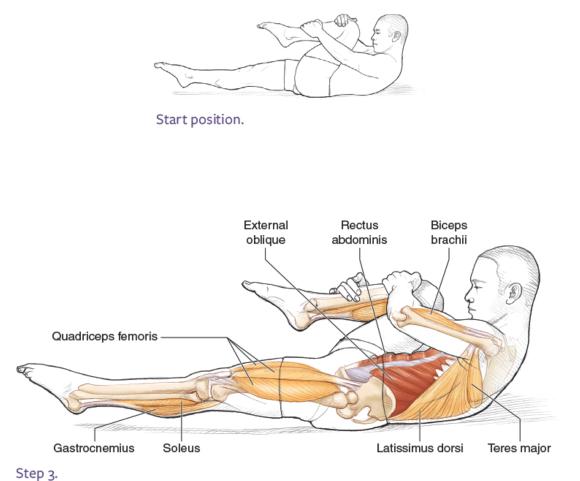Pilates one-leg stretch
This is an excerpt from Pilates Anatomy-2nd Edition by Rael Isacowitz,Karen Clippinger.
Fundamental
5-5
One-Leg Stretch
(Single-Leg Stretch)

Execution
- Start position. Lie supine with the head and scapulae off the mat in Chest Lift (exercise 4-2) position and one knee pulled into your chest. The hand on the side of the bent knee holds the shin just above the ankle. The other arm is bent, with the hand on the knee. The straight leg is at a height at which the lower back can maintain contact with the mat. Both feet are gently pointed.
- Inhale. Begin to bend the outstretched leg and straighten the bent leg.
- Exhale. Complete the switch, using an exhale as the leg fully straightens and the hands switch to the other knee as shown in the main muscle illustration. The hand on the side of the bent knee grasps the shin near the ankle, and the other hand holds the knee that is pulled toward the chest. Repeat this alternating sequence 5 times on each leg, for a total of 10 times, switching the legs with each repetition.
Targeted Muscles
Spinal flexors: rectus abdominis, external oblique, internal oblique
Accompanying Muscles
Anterior spinal stabilizer: transversus abdominis
Hip flexors: iliopsoas, rectus femoris
Hip extensors: gluteus maximus, hamstrings
Knee extensors: quadriceps femoris
Ankle-foot plantar flexors: gastrocnemius, soleus
Shoulder flexors: anterior deltoid, pectoralis major (clavicular)
Shoulder extensors: latissimus dorsi, teres major, pectoralis major (sternal)
Elbow flexors: biceps brachii, brachialis
Elbow extensors: triceps brachii
Technique Cues
- In step 1, firmly pull the abdominal wall toward the spine. Maintain solid contact of the lower back and sacrum with the mat and a stationary position of the ASIS as you use the hip flexors and extensors to switch the legs in steps 2 and 3.
- Think of constantly lifting the upper trunk up and forward off the mat with a firm contraction of the abdominals so that it stays lifted at the same height instead of dropping as the legs switch.
- While maintaining this core stability, reach one leg out in space. The knee extensors that straighten the knee and the ankle-foot plantar flexors that point the foot help to create the desired long line.
- Keep the scapulae neutral, and avoid lifting them toward the ears while the shoulder flexors work to keep the arms from dropping toward the mat when the arms switch to the opposite leg. The elbow extensors straighten the arm that reaches for the ankle while the elbow flexors start bending the arm to bring it to the opposite knee. Use the elbow flexors on both arms to help pull the knee close to the chest. Then keep the knee stationary as the hands press down on the lower leg, and bring the elbows down toward the mat so that the shoulder extensors assist with keeping the trunk lifted off the mat.
- Imagine. Imagine that your legs are moving precisely like pistons of an engine while the engine itself, the powerhouse of your body, remains as stationary as possible.
Exercise Notes
One-Leg Stretch is a valuable stability exercise that emphasizes the abdominals. The abdominals work in multiple roles to keep the trunk lifted, maintain contact between the lower back and the mat, and keep the abdominal wall pulled in. This abdominal action is necessary for maintaining pelvic and spinal stability, which the vigorous movement of the legs can easily disrupt.
Personalize Your Practice
Variation
This exercise can also be performed with the thigh of the bent leg just beyond vertical rather than close into the chest. Both hands are on that knee, with the lower part of the bent leg parallel to the mat. This alternative position can be used to emphasize curling the trunk higher to better challenge the abdominals, as well as to practice maintenance of a neutral position of the lumbar spine and pelvis.

Progression
Use the variation as described but instead of holding onto the leg, place the hands behind the head with the elbows wide. Allow the head to sit comfortably in the hands so that they can take much of the weight of the head, rather than relying solely on the muscles of the neck to support the head. This progression makes the One-Leg Stretch more difficult in terms of muscular activity and load because of the increased effective resistance created by holding the arms behind the head instead of on the leg. In addition, the support gained from holding onto the bent leg has been eliminated. Yet it does offer support for the head that helps alleviate the often-felt discomfort in the neck caused by excessive muscle tension.

SHOP

Get the latest insights with regular newsletters, plus periodic product information and special insider offers.
JOIN NOW


